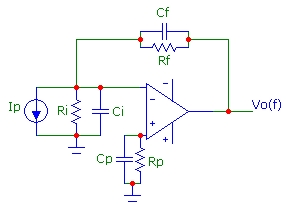
Transimpedance Noise Utility
May 11, 2012
 Cnoise.exe is a compiled C#.net console utility for Windows and requires .NET 4 runtime environment. Cnoise calculates the cumulative output voltage noise (up to some user-specified frequency) and the
total output voltage noise (integrated out to infinite frequency) for the circuit shown. The program uses the exact
transimpedance and noise-gain transfer functions
and exact integrals. Cnoise.exe also displays several useful parameters for the circuit including exact 3db bandwidths and pole/zero frequencies.
Although the circuit shown is a transimpedance configuration with a current
source Ip, the output noise calculation applies to ANY circuit configuration with the circuit elements shown: Ri, Ci, Rf, Cf, Rp, Cp.
Cnoise.exe is a compiled C#.net console utility for Windows and requires .NET 4 runtime environment. Cnoise calculates the cumulative output voltage noise (up to some user-specified frequency) and the
total output voltage noise (integrated out to infinite frequency) for the circuit shown. The program uses the exact
transimpedance and noise-gain transfer functions
and exact integrals. Cnoise.exe also displays several useful parameters for the circuit including exact 3db bandwidths and pole/zero frequencies.
Although the circuit shown is a transimpedance configuration with a current
source Ip, the output noise calculation applies to ANY circuit configuration with the circuit elements shown: Ri, Ci, Rf, Cf, Rp, Cp.
 Download cnoise.exe (21,608 bytes) (.NET 4, Digitally Signed)
Download cnoise.exe (21,608 bytes) (.NET 4, Digitally Signed)
Cnoise.exe can be invoked in two different ways using either 10 or 12 arguments:
cnoise.exe GBW en in Rf Cf Ri Ci Rp Cp F
or
cnoise.exe GBW en in Rf Cf Ri Ci Rp Cp min_pow max_pow stepF
where the circuit elements are as shown in the schematic diagram. GBW is the op-amp gain-bandwidth product (assuming a single-pole model).
en is the op-amp input spectral voltage noise density and in is the op-amp input spectral current noise density.
The first command-line specifies a single frequency F for the cumulative output noise calculation. For example to calculate the cumulative noise to 3 MHz:
cnoise.exe 19e6 6e-9 2e-15 50e3 2.6e-12 1e9 20e-12 50e3 200e-12 3e6
The second command line specifies a range of frequencies for cumulative noise calculation. For example to calculate cumulative noise for frequencies from 1 kHz to 10 MHz:
cnoise.exe 19e6 6e-9 2e-15 50e3 2.6e-12 1e9 20e-12 50e3 200e-12 3 7 1
The command-line output generated by the first example above is shown below. The definition of the output noise voltage components in μV are:
- Ven: voltage noise of en
- Vin: voltage noise of in flowing through Rf and Ri
- Vth: voltage noise of Rf and Ri (thermal noise sources)
- VinRp: voltage noise of in flowing through Rp
- VthRp: voltage noise of Rp (thermal noise source)
- Vtot: total RMS-summed output voltage noise
A set of plots using the parameters above created by simply importing the command-line output into Microsoft Excel is shown below.
C:\testfolder>cnoise 19e6 6e-9 2e-15 50e3 2.6e-12 1e9 20e-12 50e3 200e-12 3e6
GBW 19 MHz
en 6E-09 V/Sqrt(Hz)
in 2E-15 A/Sqrt(Hz)
Rf 50 kohm
Cf 2.6 pF
Ri 1000 Mohm
Ci 20 pF
Rp 50 kohm
Cp 200 pF
F0 1.636 MHz
Fz 140.852 kHz
Fp 1.224 MHz
Frp 15.915 kHz
f3db 1.627 MHz
f3dbNI 26.868 MHz
Q 0.7031
- Cumulative Output Noise (uV) to frequency 3.00E+006
Ven: 67.720
Vin: 0.131
Vth: 37.114
VinRp: 0.022
VthRp: 6.099
Vtot: 77.464
- Total Output Noise (uV) for All Frequencies
Ven: 94.015
Vin: 0.134
Vth: 38.018
VinRp: 0.022
VthRp: 6.170
Vtot: 101.599


 Cnoise.exe is a compiled C#.net console utility for Windows and requires .NET 4 runtime environment. Cnoise calculates the cumulative output voltage noise (up to some user-specified frequency) and the
total output voltage noise (integrated out to infinite frequency) for the circuit shown. The program uses the exact
transimpedance and noise-gain transfer functions
and exact integrals. Cnoise.exe also displays several useful parameters for the circuit including exact 3db bandwidths and pole/zero frequencies.
Although the circuit shown is a transimpedance configuration with a current
source Ip, the output noise calculation applies to ANY circuit configuration with the circuit elements shown: Ri, Ci, Rf, Cf, Rp, Cp.
Cnoise.exe is a compiled C#.net console utility for Windows and requires .NET 4 runtime environment. Cnoise calculates the cumulative output voltage noise (up to some user-specified frequency) and the
total output voltage noise (integrated out to infinite frequency) for the circuit shown. The program uses the exact
transimpedance and noise-gain transfer functions
and exact integrals. Cnoise.exe also displays several useful parameters for the circuit including exact 3db bandwidths and pole/zero frequencies.
Although the circuit shown is a transimpedance configuration with a current
source Ip, the output noise calculation applies to ANY circuit configuration with the circuit elements shown: Ri, Ci, Rf, Cf, Rp, Cp. 